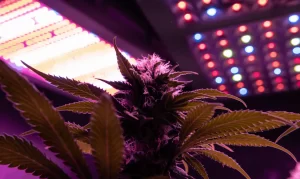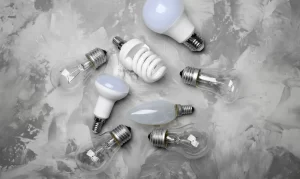How To Use Grow Lights For Houseplants? It’s never been easier to grow plants indoors. Grow lights for indoor plants allow you to grow a wide range of plants in any environment and at any time of year. These growing lights are specially built to replace natural sunlight, stimulate photosynthesis, and provide the correct color spectrum for the plant to grow and thrive. You can have juicy tomatoes in the middle of winter or award-winning violets all year with the right fixture or bulb.
There are various types of grow lights available, each with its own advantages and disadvantages. Here’s a guide to selecting the best growing lights for your needs, as well as how to install them properly.
Contents
- Choosing Grow Bulbs Vs. Lighting Fixtures: How To Use Grow Lights For Houseplants?
- Should I Buy an Incandescent, Fluorescent, or LED Light?
- Which Light Color Is Best for Plant Growth?
- Creating an Indoor Plant Growing Environment
- Grow Light Positioning Suggestions
- How Long Should The Grow Light Be Turned On For?
- What Happens When A Plant Receives Too Much Light?
- What effect does Light have on Plant Growth?
- Is there a distinction to be made between LED lights & LED development lights?
- Conclusion: How To Use Grow Lights For Houseplants?
Choosing Grow Bulbs Vs. Lighting Fixtures: How To Use Grow Lights For Houseplants?
Can you replace the bulbs in the existing light with special grow bulbs, or should you purchase a whole new fixture with built-in lighting? It all depends on what you want: ease and low cost or specialized efficiency.
Grow light bulbs are the less expensive choice. It is also simpler to use for the majority of citizens. Simply take an old lamp or ceiling light that needs bulb replacement and substitute it with a specially-made grow bulb.
Grow lighting fixtures are more costly, but they have a more comprehensive solution. A single fixture may provide lighting for multiple plants while dispersing it uniformly throughout the room. Since these fixtures are built explicitly for grow lighting, they aim to have a broader light spectrum range than less expensive light bulbs.
Should I Buy an Incandescent, Fluorescent, or LED Light?
- Incandescent Grow Lights: Incandescent grow lights are the most affordable technology, but they are also the least energy-efficient and produce much heat.
- Fluorescent Lights: Fluorescent lights provide a good spectrum of light and have a low heat signature. They are commonly available as tube lights or compact fluorescent (CFL) reflectors. Growing with fluorescent lights is more energy-efficient than growing with incandescent lights, but it is also more costly.
- LED Grow Lights: LED grows lights are the most advanced equipment available on the market today. They are incredibly energy-efficient, have a very low heat intensity, and have an ideal light spectrum range. With their low energy consumption, low heat, and color optimized for growth, LED lights are the most powerful, reliable, and customer-friendly way to grow plants at home than fluorescent or incandescent lights.
- High-Intensity Discharge (HID) Bulbs: High-Intensity Discharge (HID) bulbs generate light by creating an electric arc between tungsten electrodes within an alumina-fused tube. Commercial growers typically use these specialty bulbs because they have a very high light output level.
- Metal Halide Lights: Metal Halide lights provide a strong light source by combining mercury vapor with metal salts. They make use of a special fixture and, like HIDs, are widely used by commercial establishments.
Read more about How long to keep grow lights on Plants?
Which Light Color Is Best for Plant Growth?
- Violet-blue light with wavelengths ranging from 400 to 520 nanometers promotes chlorophyll absorption, photosynthesis, and development.
- Red light in the 610–720 spectrum range supports flowering and budding.
- Grow lights must provide the correct spectrum of light for photosynthesis, which is essential for plant growth.
- Check out the color spectrum offered before buying a lamp. Lights that can provide a full range are the best option for your growing region.
- LED lights come in handy in this situation. Most LED rising lights have all forms of color spectrum illumination, allowing you to reap the full benefits.
Creating an Indoor Plant Growing Environment
How do you get enough light for houseplants and indoor gardens? Here are three pointers on how to best organize your room.
- Take a look at your indoor garden plot. Consider how much space you have, whether it’s a single shelf, a basement section, or an entire room. Plants and beddings should be potted accordingly.
- Group the pots or trays 4 to 8 inches apart, depending on the type of plant, to allow for growth and easy access for pruning and care.
- You should also purchase lights that will illuminate your entire planting field.
- To completely cover your growing area, you can need more than one bulb or light source. Depending on the scale, you may only need one light for houseplants, or you may need many.
Grow Light Positioning Suggestions
- The best arrangement is to hang or position lights over plant beds or pots, as this mimics natural sunlight from above and exposes all sides and leaves of a plant to artificial light.
- As a rule of thumb, incandescent grow light bulbs should be at least 24 inches above your plants. Since fluorescent and LED lights emit less heat, they can be mounted 12 and 6 inches above plants, respectively.
- To maintain the proper distance, keep changing the location of the grow light as your plants evolve and mature. Exact details and instructions should be obtained from your unique model and design style.
- Also, keep in mind that the amount of light needed for indoor growth is determined by the characteristics of the plant being grown. Depending on what you want to grow, you can need different lights at different heights for different plant areas.
How Long Should The Grow Light Be Turned On For?
- Different types of plants need varying amounts of light.
- Generally, most vegetables and flowering plants need 12 to 16 hours of light per day, with flowering plants requiring the most. Plan on providing at least 8 hours of darkness a day to most plants.
- Darkness is critical to the plant’s growth cycle. During the day, sunlight assists plants in producing energy through photosynthesis. On the other hand, plants use this energy to expand and flower at night, a mechanism known as “respiration.”
- Check your seed packaging or plant tags for precise recommendations, or inquire at the nursery. Also, remember to switch off your grow lights now and then. Nobody – not even plants – enjoys working 24 hours a day.
Common Question Regarding Grow Lights
What Happens When A Plant Receives Too Much Light?
When exposed to too much sunlight, not everyone responds the same way. Some people have fair skin that turns red, while others brown and even others burn and peel. Plants are the same as humans, and their responses to “too much light” vary. When exposed to direct sunlight, they may also get sunburned. In general, you can see everything from curling or wilting leaves to scorching signs to plant death. Give a plant the sunlight it needs to prevent problems.
What effect does Light have on Plant Growth?
Sunlight is essential for the survival of all living things on the planet, including plants. Although humans obtain energy from the food they consume, plants generate their energy through a process known as photosynthesis. They absorb light from their leaves and convert it into the energy they need to grow, flower, and reproduce. Even though each plant has different sunlight requirements, which affects them differently, a plant that is deprived of sunlight will generally die.
Learn more about the Advantages of Using a Misting System.
Is there a distinction to be made between LED lights & LED development lights?
LEDs are “light-emitting diodes” that provide adequate electric lighting and have a life up to 25 times that of incandescent lamps. A grow light is an artificial light source used to promote plant development. It is typically used when natural light is insufficient for a plant. It emits light suitable for photosynthesis to provide a variety of light spectrums (both cool and warm) close to that of the sun. Grow lights come in various colors, temperatures, and intensities to accommodate various types of plants, stages of cultivation, and plant requirements.
LED grow lights are LED lights that come in various colors (wavelengths) and intensities. The perfect color and intensity for certain plants can be the same as you use for lighting. On the other hand, Standard LED lights are often either warm or cool spectrum, denying plants the full spectrum they need.
Conclusion: How To Use Grow Lights For Houseplants?
Ants require light to conduct photosynthesis, which is how special cells transform the energy in light into sugars. Plants emit oxygen during the process.
Read more about How Many Plants Can I Grow With a 300w Led Light?
Plants need varying amounts of light to survive, ranging from low-light houseplants like dracaenas to fruiting edibles like tomatoes, which require much brighter light. Seedlings need a lot of bright light to develop, and if they don’t get enough, they become poor and leggy. Even the sunniest windowsill will not provide the intensity or period of light required in most cases, particularly in winter.




